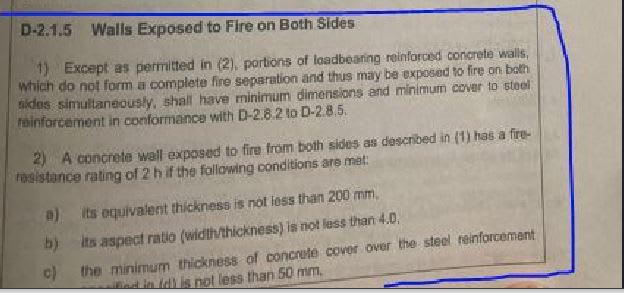Said the Sky
Structural
Hello all,
I have been requested by the architect to provide a detail for a concrete fire wall that spans about 37' ft above slab on grade (43' to top of footing)
This will be a non-load bearing wall in terms of gravity loading and will not be connected to adjacent structure on either side (free standing), so I will be designing it for cantilever loading of 0.5kpa factored lateral load or seismic loading.
According to CSA A23.3 walls exposed to fire on both sides need:
1. 200mm thickness
2. aspect ratio width/thickness of not less than 4.0. (I assume width is the length of the wall?)
3. Min 50mm cover for reinforcements
4. Reinforcing is required to be placed in vertical and horizontal in accordance with clause 10 and 14 of A23.3. Do I need to conform to Lu/30 for non load bearing walls to determine minimum thickness within clause 10&14 or do I just follow the requirements for reinforcing? if not I'll have to use a 475mm wide wall?
5.effective length of wall k*Lu is not more than 3.7m, in our case k = 2.0 for cantilever, Lu = 14m, way exceeds 3.7m.
i've attached an elevation of the fire wall in question, I have about 3 around this building, its a 3 storey residential townhome.
I've also attached the code im referring to in A23.3
looking for some advice, should I consider a different type of fire wall design, tied wall, weak-link wall, or stick with cantilever wall (more reinforcing bigger footing etc)
thanks!
I have been requested by the architect to provide a detail for a concrete fire wall that spans about 37' ft above slab on grade (43' to top of footing)
This will be a non-load bearing wall in terms of gravity loading and will not be connected to adjacent structure on either side (free standing), so I will be designing it for cantilever loading of 0.5kpa factored lateral load or seismic loading.
According to CSA A23.3 walls exposed to fire on both sides need:
1. 200mm thickness
2. aspect ratio width/thickness of not less than 4.0. (I assume width is the length of the wall?)
3. Min 50mm cover for reinforcements
4. Reinforcing is required to be placed in vertical and horizontal in accordance with clause 10 and 14 of A23.3. Do I need to conform to Lu/30 for non load bearing walls to determine minimum thickness within clause 10&14 or do I just follow the requirements for reinforcing? if not I'll have to use a 475mm wide wall?
5.effective length of wall k*Lu is not more than 3.7m, in our case k = 2.0 for cantilever, Lu = 14m, way exceeds 3.7m.
i've attached an elevation of the fire wall in question, I have about 3 around this building, its a 3 storey residential townhome.
I've also attached the code im referring to in A23.3
looking for some advice, should I consider a different type of fire wall design, tied wall, weak-link wall, or stick with cantilever wall (more reinforcing bigger footing etc)
thanks!

